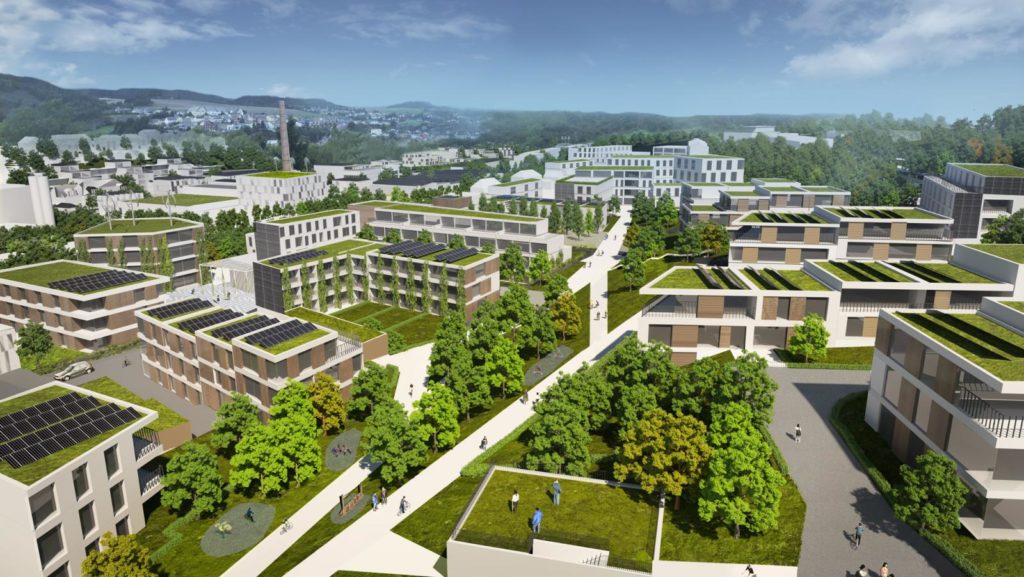Wiltz is a city in the north of the Grand Duchy of Luxembourg. The city is the only urban centre with more than 7 000 inhabitants in the sparsely populated north and is therefore classified as a national centre of attraction. Until 2030, the municipality and the state would like to see an increase of population to reinforce the city’s position as ‘capital of the north’. One step in this is a master plan for developing a 25.5 hectare district in the city centre, called ‘Wunne mat der Wooltz’.
Rationale for action
The area covered by the master plan lies between Oberwiltz and Niederwiltz and was an industrial area with many factories. The area experienced a downturn when structural changes decreased the demand for industrial goods. Already in 1996 the municipality has identified the need to develop this district next to the city centre.
The master plan shall help developing Wiltz as the capital of the North by attracting more inhabitants and jobs. This is in line with the decentralisation objectives and the ‘CAP 2030’ integrative development plan for the municipality of Wiltz (‘plan integratif du développement de la commune de Wiltz’) for the municipality and the northern region.
The plan is to merge the former districts of in der Geetz, Lambert/Baumaself and Eurofloor. The new district will support the regional development targets for 2030 to make the city more attractive for residents and businesses.

Objective
The plan envisages creating 1 000 new residential units in the new district. This will provide housing for 2 000 additional inhabitants and about 550 new jobs will be created in the new district. The 25.5 hectare project is a classic conversion as the site was previously industrial.
The new residential area will be integrated into the existing urban fabric. New green public spaces and public functions (i.e. schools) will not only be used by new residents. They shall also become points of attraction for the inhabitants of the surrounding districts. Additionally, the area will connect two neighbourhoods previously separated by the industrial site.
Time frame
The technical feasibility study was conducted between 2010 and 2011. The master plan was developed from 2013 to 2017 and construction started in 2018. The district will be finalised until 2030.
Implementation steps and processes
Since 1996, the municipality of Wiltz has underlined the potential to transform an der Wooltz into a new residential district. However, the city did not have the financial means to realise an independent development. In 2010, the state reviewed the city’s plan and contracted a technical preparatory study as well as an urban management plan as input for the local land-use plan. In the meantime, a concept for de-pollution was elaborated. From 2013 to 2017, a master plan detailing the construction was created with the cooperation of 19 public partners. The first civil works, namely tearing down the factory buildings and de-polluting the soil ran from 2014 to 2015. With the finalisation of the master plan in 2017, the planning stage was completed and the concept was presented to the public.
Development involved 19 public actors working closely together. The master plan is thus a result of thorough cooperation between different public representatives and fields of expertise (housing, environmental protection, commerce, etc.).

Required resources
The costs amounted to EUR 2 300 000 for planning, demolition and de-pollution of the former industrial area.
Results
The planning and the preparatory works have been completed. Construction however will only start after the approval of the PAP (specific land use plans), which act as building permits. They were submitted for approval in late 2017 and approved in 2018. Since then, construction for developing the new district started.
Construction and assignment of units will be organised through Fonds du Logement, a public developer, guaranteeing a social mix of residents in the new district. Housing will be assigned conditional on low household income, or the number of children.
Experiences, success factors, risks
With units for 1 800 inhabitants, the city will be able to increase its population by 30%. The district does not only target residents currently living outside of the municipality. Key to success is to encourage also current residents to move to the new district, for instance by making the new housing units more attractive and comfortable than those currently available in the surrounding neighbourhoods.

Conclusions
Pressure on housing in Wiltz is less strong than in central or southern Luxembourg. Within the city and surrounding villages, the urban fabric could still absorb more new residents. The example of Wunne mat der Wooltz must be seen against very positive demographic and economic forecasts for the country in the upcoming years. At the same time, the government is pursuing a decentralisation policy, making regional centres more attractive. A significant increase in population and businesses in regional centres such as Wiltz, is envisaged.
The example follows the tradition of planning flagship projects in Luxembourg. Compared to other available areas in villages and cities, conversions could be a more general instrument of spatial planning and territorial development. So far, these urban developments are still exceptions not least because they are large and require significant finance. Providing a toolbox to municipalities could also give local administrations the opportunity to implement smaller conversion projects independently from the state. Collaboration across different levels in a small country such as Luxembourg risks local interests being strongly influenced by state objectives.

Contact
Wiltz City Management: citymanagement@wiltz.lu





